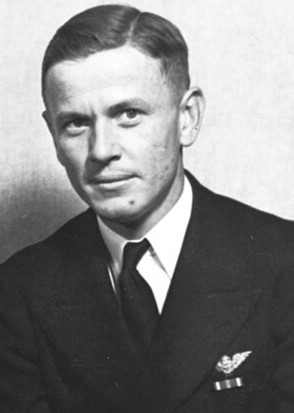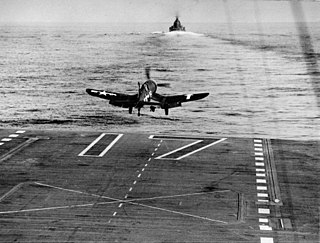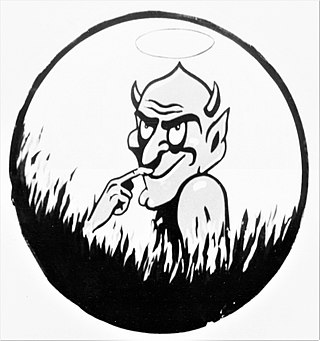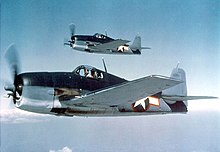
The Grumman F6F Hellcat is an American carrier-based fighter aircraft of World War II. Designed to replace the earlier F4F Wildcat and to counter the Japanese Mitsubishi A6M Zero, it was the United States Navy's dominant fighter in the second half of the Pacific War. In gaining that role, it prevailed over its faster competitor, the Vought F4U Corsair, which initially had problems with visibility and carrier landings.
Henry Barrett Tillman is an American author who specializes in naval and aviation topics in addition to fiction and technical writing.

Alexander Vraciu was a United States Navy fighter ace, Navy Cross recipient, and Medal of Honor nominee during World War II. At the end of the war, Vraciu ranked fourth among the U.S. Navy's flying aces, with 19 enemy planes downed during flight and 21 destroyed on the ground. After the war, he served as a test pilot and was instrumental in forming the post-war Naval and Marine Air Reserve program. From 1956 to 1958 Vraciu led his own fighter squadron, VF-51, for twenty-two months. He retired from the U.S. Navy with the rank of commander on December 31, 1963. Vraciu later moved to Danville, California, and worked for Wells Fargo.

Eugene Anthony Valencia Jr. was a 3rd highest scoring United States Navy fighter ace in World War II with 23 claims.

John Thomas Blackburn was an American naval aviator, World War II flying ace, and the first commanding officer of the famed F4U Corsair squadron VF-17 Jolly Rogers.

Arthur Ray "Hawk" Hawkins was an American naval aviator and flying ace of World War II. He was the United States Navy's tenth leading ace with 14 aerial victories to his credit.

Rear Admiral Edward Lewis Feightner was a United States Navy officer who fought in a number of significant battles in the World War II Pacific Theater of Operations. During two combat tours, he shot down nine enemy aircraft to become a flying ace.

Charles Goold Cleveland was an American Air Force lieutenant general and flying ace who was commander of the Air University, Maxwell Air Force Base, Alabama. He was the longest lived American fighter ace of the Korean War. After the death of Wang Hai in August 2020, he was the last living flying ace from the Korean war. He was the recipient of the Silver Star, the Air Force Distinguished Service Medal and the Meritorious Service Medal.

Frederick Rounsville "Fritz" Payne Jr. was a World War II Ace and a brigadier general in the United States Marine Corps. Payne was awarded the Navy Cross for service with VMF-212.

Captain Cecil Elwood "Cece" Harris was an American schoolteacher, naval aviator and flying ace of World War II. Harris is remembered for actions in the Pacific Ocean Theater, which earned him nine combat medals including the Navy Cross, the highest award for valor after the Medal of Honor. He ended the war as the navy's second-highest-scoring ace after David McCampbell (34), credited with shooting down 24 Japanese planes. Harris scored 16 of his aerial victories in four different days, downing four enemy aircraft on each of those days. Never during the course of his 88-day tour with VF-18 did a bullet hit his aircraft. It has been said that Harris "was arguably the most consistently exceptional fighter pilot in the US Navy".
Fighter Squadron 15 or VF-15 was an aviation unit of the United States Navy. Originally established on 1 September 1943, it was disestablished on 20 October 1945. During six months of combat in 1944 the squadron destroyed more enemy planes than any other squadron in the Pacific War. Twenty-six of the squadron's pilots became aces.

Fighter Squadron 84 or VF-84 was an aviation unit of the United States Navy. Originally established on 1 May 1944, it was disestablished on 8 October 1945. It was the first US Navy squadron to be designated as VF-84.

Ira Cassius Kepford was an American flying ace of World War II who served with a land-based unit of the United States Navy. In 76 days of combat flying with the VF-17 "Jolly Rogers," he was credited with shooting down 16 enemy aircraft. At the close of his combat service in April 1944, Kepford was the Navy's leading ace.

Commander Hamilton McWhorter III was a United States Navy aviator and a flying ace of World War II, credited with shooting down twelve Japanese aircraft. He was the first Hellcat ace, first USN carrier-based double ace, and the first Grumman F6F Hellcat pilot to achieve double ace status. He flew 89 combat missions during World War II while flying with the VF-9 and VF-12 units. On May 23, 2014, he was also posthumously awarded the American Fighter Aces Congressional Gold Medal, when the United States Congress collectively awarded the gold medal to all flying aces: a navy pilot is depicted on the medal in the upper right.

Dean Samuel "Diz" Laird was the only U.S. Navy ace to have combat victories in both the Pacific and European theaters of World War II. He served in World War II, the Korean War, and the Vietnam War, and is given credit for 5.75 aerial victories. Laird flew 138 fighter missions during World War II. and was awarded the Distinguished Flying Cross and the Congressional Gold Medal, among other honors.

Clayton Kelly Gross, from Walla Walla, Washington, was a Army Air Forces World War II Ace who shot down 6 enemy planes over Europe. Gross also flew planes in the D-Day invasion of Normany, France both on June 5 and 6, 1944. He was a recipient of the American Fighter Aces Congressional Gold Medal, the Distinguished Flying Cross and the Silver Star. He flew in 105 combat missions during WWII.

Fighting Squadron 18 (VF-18) was an aviation unit of the United States Navy which served aboard USS Intrepid (CV-11) in the fall of 1944. It was the second squadron to bear the designation VF-18.
MajErnest Shipman U.S. Army Air Force from Saginaw, Michigan was an American World War II Ace pilot who shot down seven aircraft in the Mediterranean theatre of World War II.

MjrFrank Bernard Baldwin from Pittsburg, Michigan was a United States Marine Corps World War II Ace pilot who shot down 10 enemy aircraft in combat. He was the recipient of the Distinguished Flying Cross.

Norman E. Olson was a U.S. Army Air Forces World War II flying ace. He shot down seven enemy aircraft in the European theatre of World War II. Olson died in aerial combat on April 8, 1944. He was the first Ace pilot of the 355th Fighter Group.


















